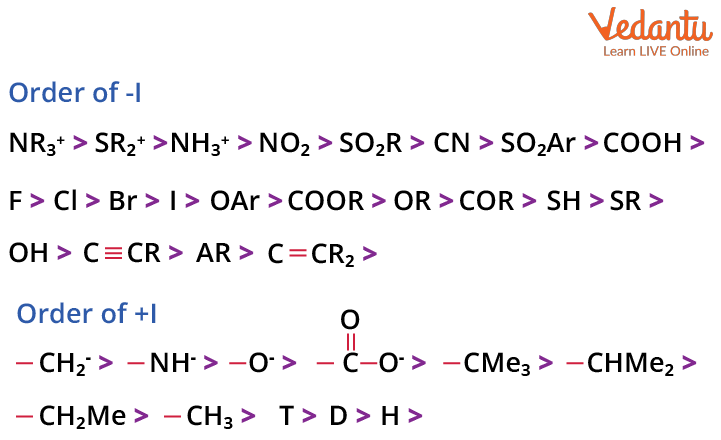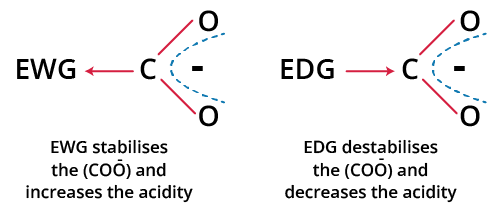




What is Inductive Effect?
A partial shift/displacement of electrons towards a more electronegative atom of a bond is known as the inductive effect. This means single bond electrons shift towards an atom with a higher electronegativity value. The associated negative or positive charge is conveyed across the carbon chain by the atoms belonging to it when an electron-releasing or electron-withdrawing species is introduced to a chain of atoms (usually a carbon chain).
The inductive effect is the formation of a permanent dipole in the molecule as a consequence of EDG or EWG. When a covalent connection is formed between atoms with different electronegativity, the electron density shifts towards the more electronegative atoms.
Example of an inductive effect is:

Image: Example of inductive effect
Types of Inductive Effect
There are two types of inductive effect: negative inductive effect and positive inductive effect.
Negative Inductive Effect(-I): When an electronegative atom, such as a halogen, is added to a chain of atoms (usually carbon atoms), the unequal sharing of electrons produces a positive charge that is carried through the chain. The resulting effect is known as the electron-withdrawing inductive effect, or the -I effect, since it generates a permanent dipole in the molecule where the electronegative atom has a negative charge and the other atom generates a positive charge.
Positive Inductive(+I): The charge is relayed through a carbon chain when a chemical species with the tendency to release or donate electrons, such as an alkyl group, is introduced, it is known as the Positive Inductive Effect or the +I Effect. This effect is due to an electron donating group and it results in generating a negative charge to which the group is attached.
Inductive Effect Order
The distance between the substituted group and the primary group that reacts affects the strength of the inductive action. The longer the distance, the weaker the impact.

Image: Inductive effect order
Applications of Inductive Effect
Acidic strength of carboxylic acid.
Stability of canonical forms.
The relative strength of bases.
Compare the stability of carbocation, carbanion, and free radicals.
Acidic Strength
Acidic strength is a measurement of an acid's ability to lose its H+ ion. A strong acid's dissociation in solution is nearly complete. Powerful acids include hydrochloric acid, perchloric acid, nitric acid, and sulfuric acid.
A weak acid partially dissociates in the presence of both the undissociated acid and its dissociation products in the solution. Take acetic acid for example. A weak organic acid's strength is determined by substituent effects. As a result, evaluating the relative strength of substituents attached by the inductive effect order can be used to predict the order of acidic strength.
How to Determine Acidic Strength?
The stability of an acid's conjugate base is directly proportional to the acid's strength in an organic molecule. To put it differently, an acid with a more stable conjugate base is more acidic than the one with a less stable conjugate base.
Acidic molecules contain structural characteristics that allow the conjugate base anion to delocalize its charge over a larger area. The molecule is more stable when the negative charge is delocalized. The electronegativity, hybridization, and size of the atom on which the negative charge is placed, the electron-withdrawing actions of nearby electronegative atoms, and resonance effects are the most critical features that stabilise negative charges. Hence, by estimating the stability of a conjugate base formed, we can estimate and compare the acidic strength of an organic compound.
Relation of Acidic Strength with Inductive Effect
We can forecast the acidity and basicity of substances using the inductive effect. In general, electron-withdrawing groups (EWG) increase the acidity of a chemical whereas electron-donating groups (EDG) decrease the acidity of a compound.
For example, in carboxylic acid, an electron withdrawing group withdraws excess electron density from a conjugate base formed, thus stabilising it. Hence, acidic strength increases similarly. If an electron donating group is attached to carboxylic acid, it increases the electron density on the conjugate base formed. Hence, decreasing the acidic strength.

Image: Effect of EWG and EDG on Carboxylic Acid
It should also be noted that since the number of electron withdrawing substituents increases, acidic strength increases. Mesomeric effect and resonance effect dominate over inductive effect generally. However, in the case of halogens, the inductive effect dominates over any other effect.
Inductive Effect on Stability
In the case of carbocations, a group having the -I effect group attached to it decreases the stability and +I effect group increases the stability. This goes similarly in the case of free radicals. In the case of carbanion, a group having +I effect group attached to it decreases the stability and -I effect group increases the stability.
Conclusion
A partial shifting or displacement of electrons toward a bond's more electronegative atom is known as an inductive effect. This indicates that single bond electrons move toward an atom that is more electronegative. We have seen there are two types of inductive effect: negative inductive effect and positive inductive effect. The distance between the substituent group and the primary group that reacts affects the strength of the inductive action. We also discussed the order of strength of inductive effects for different groups. In general, electron-withdrawing groups (EWG) increase the acidity of a chemical whereas electron-donating groups (EDG) decrease the acidity of a compound.






FAQs on Inductive Effect and Acidic Strength - Types, Relation and Applications for JEE
1. What are resonance structures?
The delocalization of electrons in a polyatomic ion or molecule is described as resonance structures, which are sets of Lewis structures. Due to the presence of partial charges and fractional bonds, a single Lewis structure frequently fails to explain the bonding in a molecule/polyatomic ion. Chemical bonding is described using resonance structures in such cases.
A group of two or more Lewis structures that collectively represent the electronic bonding of a single polyatomic species, including fractional bonds and fractional charges, is known as a resonance structure.
2. Define mesomeric effect.
In Chemistry, the mesomeric effect is a property of substituents or functional groups in a molecule. The polarity created in a molecule by the interaction of two pi bonds or a pi bond and a lone pair of electrons on a nearby atom is known as the mesomeric effect. Based on relevant resonance structures, the effect is utilised in a qualitative way to explain the electron withdrawing or releasing properties of substituents. Because the inductive effect is solely based on the electronegativity of the atoms, the mesomeric effect as a result of p-orbital overlap (resonance) has no influence on it.



































